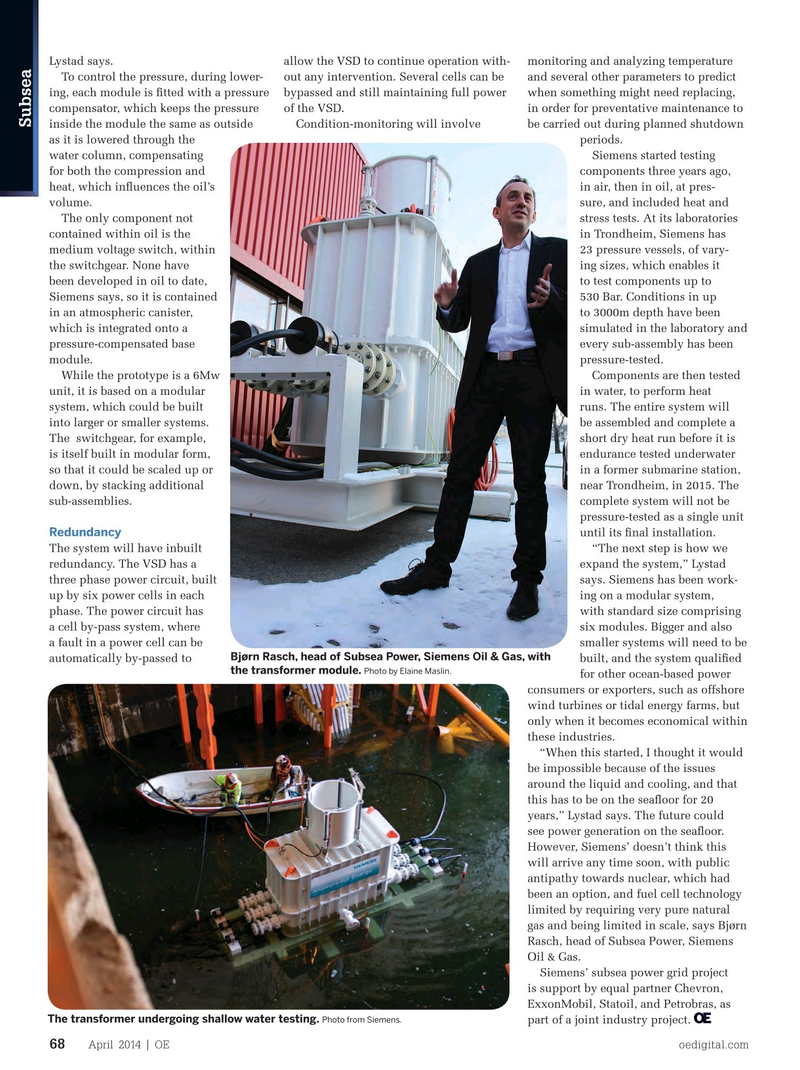
Page 66: of Offshore Engineer Magazine (Apr/May 2014)
Read this page in Pdf, Flash or Html5 edition of Apr/May 2014 Offshore Engineer Magazine
Lystad says. allow the VSD to continue operation with- monitoring and analyzing temperature
To control the pressure, during lower- out any intervention. Several cells can be and several other parameters to predict ing, each module is ftted with a pressure bypassed and still maintaining full power when something might need replacing, compensator, which keeps the pressure of the VSD. in order for preventative maintenance to
Subsea inside the module the same as outside Condition-monitoring will involve be carried out during planned shutdown as it is lowered through the periods. water column, compensating Siemens started testing for both the compression and components three years ago, heat, which infuences the oil’s in air, then in oil, at pres- volume. sure, and included heat and
The only component not stress tests. At its laboratories contained within oil is the in Trondheim, Siemens has medium voltage switch, within 23 pressure vessels, of vary- the switchgear. None have ing sizes, which enables it been developed in oil to date, to test components up to
Siemens says, so it is contained 530 Bar. Conditions in up in an atmospheric canister, to 3000m depth have been which is integrated onto a simulated in the laboratory and pressure-compensated base every sub-assembly has been module. pressure-tested.
While the prototype is a 6Mw Components are then tested unit, it is based on a modular in water, to perform heat system, which could be built runs. The entire system will into larger or smaller systems. be assembled and complete a
The switchgear, for example, short dry heat run before it is is itself built in modular form, endurance tested underwater so that it could be scaled up or in a former submarine station, down, by stacking additional near Trondheim, in 2015. The sub-assemblies. complete system will not be pressure-tested as a single unit
Redundancy until its fnal installation.
The system will have inbuilt “The next step is how we redundancy. The VSD has a expand the system,” Lystad three phase power circuit, built says. Siemens has been work- up by six power cells in each ing on a modular system, phase. The power circuit has with standard size comprising a cell by-pass system, where six modules. Bigger and also a fault in a power cell can be smaller systems will need to be
Bjørn Rasch, head of Subsea Power, Siemens Oil & Gas, with automatically by-passed to built, and the system qualifed the transformer module. Photo by Elaine Maslin.
for other ocean-based power consumers or exporters, such as offshore wind turbines or tidal energy farms, but only when it becomes economical within these industries. “When this started, I thought it would be impossible because of the issues around the liquid and cooling, and that this has to be on the seafoor for 20 years,” Lystad says. The future could see power generation on the seafoor.
However, Siemens’ doesn’t think this will arrive any time soon, with public antipathy towards nuclear, which had been an option, and fuel cell technology limited by requiring very pure natural gas and being limited in scale, says Bjørn
Rasch, head of Subsea Power, Siemens
Oil & Gas.
Siemens’ subsea power grid project is support by equal partner Chevron,
ExxonMobil, Statoil, and Petrobras, as
The transformer undergoing shallow water testing. Photo from Siemens.
part of a joint industry project.
April 2014 | OE oedigital.com 68 000_OE0414_Susbea-2.indd 68 3/22/14 8:42 PM

 65
65

 67
67